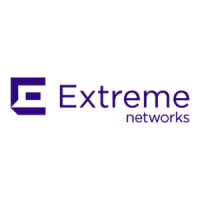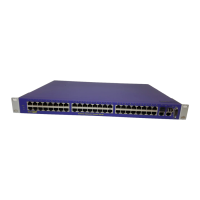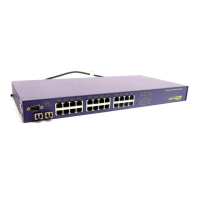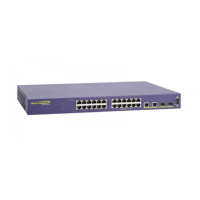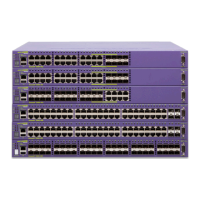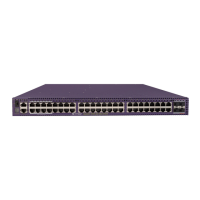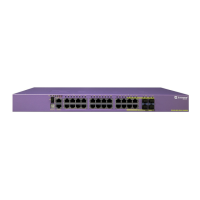Do you have a question about the Extreme Networks Summit1 and is the answer not in the manual?
Lists the different Summit switch models available in the product family.
Provides an overview of the key capabilities and functionalities of Summit switches.
Explains the concept and benefits of Virtual LANs for network segmentation.
Crucial safety guidelines to follow before installing or maintaining the switch.
Step-by-step instructions for physically installing the switch in a rack or free-standing.
Initial steps for logging into the switch and performing basic configuration.
Explanation of how to properly enter commands using the switch's command-line interface.
Steps for setting up user and administrator accounts and managing access levels.
Instructions for assigning IP addresses and subnet masks to VLANs for network management.
Guide to accessing and using the web-based management interface for the switch.
How to enable or disable individual switch ports using command-line interface.
Explains how to configure load sharing for increased bandwidth and resilience between switches.
Guide to configuring port mirroring for network traffic analysis and monitoring.
Introduces the concept of Virtual LANs and their benefits for network administration.
Explains how to create and configure VLANs based on specific switch ports.
Covers the use of 802.1Q tagging for spanning VLANs across multiple switches.
Explanation of the switch forwarding database and its role in frame forwarding decisions.
Describes the different types of entries stored in the FDB (dynamic, static, blackhole).
Commands and procedures for creating, modifying, and managing FDB entries.
Explains the purpose of STP in providing fault tolerance and preventing network loops.
Information on partitioning the network into Spanning Tree Domains (STPDs) for independent STP instances.
Step-by-step instructions for creating STP domains and enabling STP functionality.
Introduction to Quality of Service (QoS) and its role in managing network traffic levels.
Details the two QoS modes (ingress and egress) and their respective capabilities.
Instructions for creating custom QoS profiles and assigning bandwidth and priority parameters.
Introduction to the Summit's Layer 3 IP unicast routing capabilities.
How VLANs are used as router interfaces for IP traffic routing.
Information on manually configuring static routes for specific network paths.
Comprehensive guide to setting up IP unicast routing, including VLANs and routing protocols.
Compares the fundamental differences, advantages, and limitations of RIP and OSPF.
Introduction to the Routing Information Protocol (RIP) and its operation.
Introduction to the Open Shortest Path First (OSPF) protocol and its link-state algorithm.
Introduction to IP multicast routing and its core functions.
How IGMP snooping reduces flooding of IP multicast traffic by intelligent layer 2 devices.
Steps to configure the switch for IP multicast routing, including devicemode and protocols.
Overview of the switch's status monitoring facility for system information.
How to view detailed statistics for each port, including link status and packet counts.
Details on how the switch logs configuration and fault information, including levels and subsystems.
Steps to configure the switch for remote logging to a Syslog host.
How to enable or disable web-based access to the switch's management interface.
Instructions for accessing the switch's web-based management interface via URL.
Methods for saving configuration changes to the switch's non-volatile RAM.
Procedures for upgrading the switch software image using TFTP or XMODEM.
Commands for rebooting the switch immediately or scheduling a reboot.
How to save the current switch configuration to primary or secondary storage.
Essential safety precautions to read before installing the Summit switch.
Safety guidelines related to power connection, grounding, and adapter usage.
Safety guidelines and disposal information for the internal lithium battery.
Specifications for the physical size and weight of the Summit switch.
Operating and storage environmental conditions for the switch.
Information on FCC, CSA, VCCI, and other EMC compliance standards.
Explains the meaning of various LED indicators on the switch and their behavior.
Troubleshooting common issues encountered when using the CLI.
Procedures for recovering or resetting administrator passwords.
Lists the different Summit switch models available in the product family.
Provides an overview of the key capabilities and functionalities of Summit switches.
Explains the concept and benefits of Virtual LANs for network segmentation.
Crucial safety guidelines to follow before installing or maintaining the switch.
Step-by-step instructions for physically installing the switch in a rack or free-standing.
Initial steps for logging into the switch and performing basic configuration.
Explanation of how to properly enter commands using the switch's command-line interface.
Steps for setting up user and administrator accounts and managing access levels.
Instructions for assigning IP addresses and subnet masks to VLANs for network management.
Guide to accessing and using the web-based management interface for the switch.
How to enable or disable individual switch ports using command-line interface.
Explains how to configure load sharing for increased bandwidth and resilience between switches.
Guide to configuring port mirroring for network traffic analysis and monitoring.
Introduces the concept of Virtual LANs and their benefits for network administration.
Explains how to create and configure VLANs based on specific switch ports.
Covers the use of 802.1Q tagging for spanning VLANs across multiple switches.
Explanation of the switch forwarding database and its role in frame forwarding decisions.
Describes the different types of entries stored in the FDB (dynamic, static, blackhole).
Commands and procedures for creating, modifying, and managing FDB entries.
Explains the purpose of STP in providing fault tolerance and preventing network loops.
Information on partitioning the network into Spanning Tree Domains (STPDs) for independent STP instances.
Step-by-step instructions for creating STP domains and enabling STP functionality.
Introduction to Quality of Service (QoS) and its role in managing network traffic levels.
Details the two QoS modes (ingress and egress) and their respective capabilities.
Instructions for creating custom QoS profiles and assigning bandwidth and priority parameters.
Introduction to the Summit's Layer 3 IP unicast routing capabilities.
How VLANs are used as router interfaces for IP traffic routing.
Information on manually configuring static routes for specific network paths.
Comprehensive guide to setting up IP unicast routing, including VLANs and routing protocols.
Compares the fundamental differences, advantages, and limitations of RIP and OSPF.
Introduction to the Routing Information Protocol (RIP) and its operation.
Introduction to the Open Shortest Path First (OSPF) protocol and its link-state algorithm.
Introduction to IP multicast routing and its core functions.
How IGMP snooping reduces flooding of IP multicast traffic by intelligent layer 2 devices.
Steps to configure the switch for IP multicast routing, including devicemode and protocols.
Overview of the switch's status monitoring facility for system information.
How to view detailed statistics for each port, including link status and packet counts.
Details on how the switch logs configuration and fault information, including levels and subsystems.
Steps to configure the switch for remote logging to a Syslog host.
How to enable or disable web-based access to the switch's management interface.
Instructions for accessing the switch's web-based management interface via URL.
Methods for saving configuration changes to the switch's non-volatile RAM.
Procedures for upgrading the switch software image using TFTP or XMODEM.
Commands for rebooting the switch immediately or scheduling a reboot.
How to save the current switch configuration to primary or secondary storage.
Essential safety precautions to read before installing the Summit switch.
Safety guidelines related to power connection, grounding, and adapter usage.
Safety guidelines and disposal information for the internal lithium battery.
Specifications for the physical size and weight of the Summit switch.
Operating and storage environmental conditions for the switch.
Information on FCC, CSA, VCCI, and other EMC compliance standards.
Explains the meaning of various LED indicators on the switch and their behavior.
Troubleshooting common issues encountered when using the CLI.
Procedures for recovering or resetting administrator passwords.
| Product Type | Switch |
|---|---|
| MAC Address Table Size | 16, 000 |
| Jumbo Frame Support | Yes |
| Power over Ethernet (PoE) | Optional |
| Dimensions (W x D x H) | 44.1 cm x 25.4 cm x 4.4 cm (17.4 in x 10.0 in x 1.73 in) |
| Storage Temperature | -40°F to 158°F (-40°C to 70°C) |
